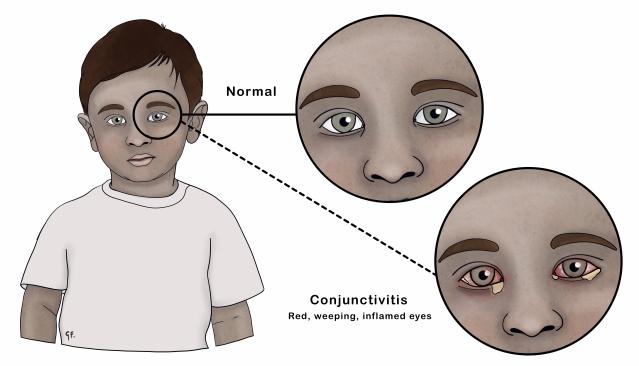Key points about conjunctivitis
- conjunctivitis is a common problem in tamariki
- it causes red, irritated and sticky eyes
- an infection or allergic reaction are the most common causes of conjunctivitis
- symptoms can last from 2 days to 3 weeks
- conjunctivitis spreads easily - good hygiene (especially hand washing) can help prevent the spread
- see your health professional if your baby with conjunctivitis is less than 6 weeks old
What is conjunctivitis?
Conjunctivitis causes inflammation of the eyelids and eyes. Conjunctivitis is sometimes called 'pink eye'.

Causes of conjunctivitis
Infection or allergy are the most common causes of conjunctivitis.
Infection
Conjunctivitis can be caused by a virus or bacteria and can spread easily.
Tamariki can catch it by touching their eyes after touching discharge from the eyes or nose of someone with the infection. It can also spread by touching surfaces and sharing things an infected person has touched.
Allergy
Allergic conjunctivitis happens when allergens come into contact with the eyes, and they trigger a reaction.
Common allergens include pollen, grasses, pet hair and dust mites.
Allergic Conjunctivitis In Children
Signs and symptoms of conjunctivitis
It can be difficult to tell whether an allergy, bacteria or a virus is causing the conjunctivitis as the symptoms are similar.

Tamariki with conjunctivitis often have:
- redness of the eyes
- itchy eyes
- discharge (may be clear, milky or pus-like)
- watery teary eyes
- puffy eyelids
- irritation or a gritty feeling (like having sand in the eye)
- crusting around the eyes
When to get medical help
See a health professional if you are worried about your child's eyes, or if your child has:
- increased swelling, redness, and tenderness around the eye
- a fever and is generally unwell
- changes in their vision
- eye pain
- sensitivity to light (photophobia)
These symptoms may suggest a serious infection. Sometimes it's a sign of cellulitis. If your child has these symptoms, see a health professional urgently.
If your baby with conjunctivitis is less than 6 weeks old, always see a health professional. Rarely, newborn pēpi (babies) can get bacterial conjunctivitis after a vaginal delivery. Certain kinds of bacteria can cause serious infection for your baby if it isn't treated urgently.
Treating conjunctivitis
Your health professional may prescribe eye drops or ointment.
How long conjunctivitis can last
Conjunctivitis can last from 2 days to sometimes as long as 3 weeks.
Caring for your child with conjunctivitis at home
You can help relieve the symptoms of conjunctivitis.
Clear away the discharge
Gently clear away the discharge from the eye with a cotton ball soaked in warm water. Clean in one direction only, moving the cotton ball from the inside to the outside of the eye. Use a separate cotton ball for each eye and throw them away after each use.
Good hygiene can help prevent the spread of conjunctivitis
- wash hands very carefully after contact with infected eyes
- try to discourage your child from rubbing their eyes
- wash pillowcases, face cloths and towels frequently and don't share them
Breastmilk
Your midwife may recommend you try using breastmilk to help clear your baby's eyes.
Keep your child with conjunctivitis away from school or daycare
Tamariki with conjunctivitis should not go to school or daycare until their eyes are better. That's because the discharge from their eyes can pass the infection on to other tamariki.
Other causes of watery, red or swollen eyes
Cellulitis
If the skin around your child's eye becomes swollen, red or sore, it may be infected. This can be serious - sometimes it's a sign of cellulitis. If this happens, take your child to a health professional as soon as possible.
Stye
A stye is a red lump on your child's eyelid. It's caused by a blockage of an oil gland in the eyelid.
Eye injury
The following can cause redness, swelling and pain in a child's eyes:
- being hit or scratched in the eye
- something getting in the eye (such as a piece of metal or glass)
- chemicals splashed in the eye
If your child has an eye injury, take them to a health professional or emergency department as soon as possible.
If your child has had chemicals splashed in their eye, they need immediate first aid. Wash their eye(s) with water for at least 10 minutes and then take your child to a health professional straight away.
Blocked tear duct
Some pēpi can have sticky eyes which don't get better. They may have watery discharge from one eye over many weeks. If your baby's eye is watery but not red, they may have a blocked tear duct rather than conjunctivitis. Tear ducts drain tears from the eyes to the nose.
Blocked tear ducts often get better by themselves. If your baby still has sticky watery eyes at about 12 months of age, they may need a small operation to help open the tear duct. See a health professional if your baby still has watery, sticky eyes when they are 10 to 12 months.
Your baby won't spread any germs from a blocked tear duct so they can still go to daycare.
Acknowledgements
Illustration of child with conjunctivitis by Dr Greta File. Property of KidsHealth.
Photos: iStock.
